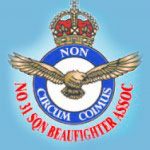Harold Horton
Harold Horton
Flight Lieutenant, Harold (Harry) George Patrick Horton, born 27th October 1921 – died 21st November 1971.

Service: Royal Australian Air force
Service Number: 13792
“Harry” enlisted into the RAAF at Kensington Victoria on the 4th April 1941 as a AC / Trainee WT operator. When discharged on the 29 August 1946, he was a member of 36 Squadron and had attained the rank of Flight Lieutenant.
This profile provides a general overview of his time served in the RAAF and focuses heavily on the period when he served as a member of 31 Squadron at Coomalie Creek in the Northern Territory, as a navigator alongside his pilot Reg “Killer” Kilpatrick.
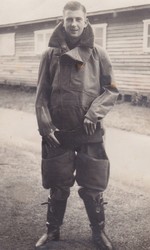
Harry in Flying Suit
Harry had been a cadet for 2 years in 34th FT Company, Royal Australian Engineers, and had undertaken some training with the Wireless Institute of Australia in Morse code prior to enlisting. He was given the nickname of Joe (“no, you cant do that Joe”) following an early event in his service career and it stuck with him until after the war. As a result, some people may have known him under this nickname throughout his period in the Air force.
Harry completed his wireless training in May 1942 at the Signals School Point Cook in Victoria, followed by Air Observer Navigator Training at No.1 Air Observers School Cootamundra NSW. (completed August 1942) He then completed his Bomb Aimer – Air Gunner training in November 1942 at No.1 B.A.G.S. and at Evans Head. This training was carried out in DH86, Oxford, Fairy Battle and predominately Anson aircraft with a number of different pilots.
In December 1942 Harry commenced flying as F/Sgt navigator with Reg “Killer” Kilpatrick as pilot with No.5 Operational Training Unit at Wagga Wagga. He initially flew in Beaufort Bombers and then successfully completed his conversion course to Beaufighters on the 7th February 1943, by which time he had logged approximately 162 hours flying time with around 53 hours in Beaufighters.
Harry joined 31 Squadron at Wagga-Wagga on 14th Feb. 1943 and after about a week of acceptance flying commenced the ferry flight in Beaufighter A19-84 from Wagga-Wagga via Charleville and Cloncurry to Darwin, Northern Territory (NT) arriving at Coomalie Creek on the 20th Feb 1943.
Unfortunately, after only a couple of days flying familiarization and navigation exercises in the NT, and after flying his first convoy cover, his pilot Reg Kilpatrick, crashed the Beaufighter A19-66, turning it right over on landing.
Extract from logbook:
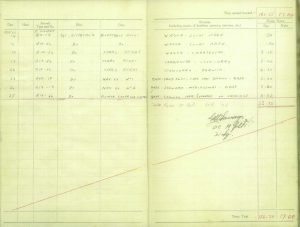
Crashed on Landing
Entry reads; “Feb 25, A19 – 66, Pilot Sgt. Kilpatrick, Fighter cover for convoy, Base – Convoy – Base (crashed on landing)” According to the reference BEAUFORT, BEAUFIGHTER AND MOSQUITO – IN AUSTRALIAN SERVICE by Stuart Wilson, A19-66 “crashed on landing Coomalie NT 03/43 and was written off”.
His pilot Reg was not hurt, but Harry suffered a possible skull fracture and would probably have been killed if he had not been belted in. Harry (and Killer’s) first stint with 31 Squadron was indeed short lived being only some 11 days. Harry was placed in hospital at 1 MRS between 25/2/43 and 1/3/43 as a result of the accident.
Reg Kilpatrick was sent south for further training (Reference: Coomalie Charlies Commandos a book written from the memoires of Kenneth MacDonald), for retraining. Harry, after recovering from the accident, re-joined No.5 Operational Training Unit (OTU) at Wagga-Wagga where after flying with a number of different pilots including F/Lt Gordon and Wing Commander Lee, he again teamed up with Sgt “Killer” Kilpatrick as pilot, and undertook further exercises in air observation, gunnery, strafing and tactics.
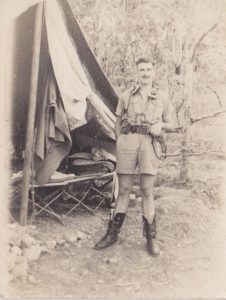
Harry outside his Tent at Coomalie
Harry re-joined 31 Squadron on the 20th May 1943 with Killer as pilot and undertook the ferry flight in Beaufighter A19-117 from Laverton via Wagga-Wagga and Cloncurry arriving at Coomalie Creek NT on the 24th May 1943. After arrival and initial familiarization flights Harry and Reg commenced operational flights as part of fighter cover for convoy on the 30th May 1943.
On the 17th July during a morning strike on Taberfane “Killer” and Harry were credited with their first kill in the squadron. The aircraft was a Japanese Rufe destroyed in aerial combat.
Extract from log book records: 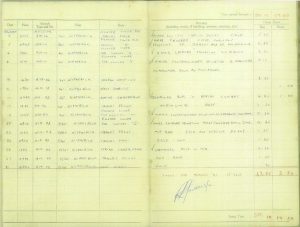
“July 17, A19 – 98, Pilot Sgt. Kilpatrick, Strike Taberfane, Destroyed Rufe in aerial combat”
During the period from May to November 1943, Harry and Killer were engaged in many exercises and missions undertaken by 31 Squadron e.g. strikes (Taberfane, Selaroe Island, Tanimbar Island), fighter cover for convoys, Air Sea Rescue, fighter cover for HMAS ships, fighter cover for special ops to Timor, and various other duties (there are detailed records of these operations and sorties contained within Harry’s logbook).
“Killer” and Harry flew a large number of Beaufighters during this period including the aircraft numbers:
A19-16, 17, 18, 36, 40, 63, 66 (crashed on landing), 78, 80, 82 (crashed on take off). 83, 84, 86, 98, 103, 119, and A19- 140,
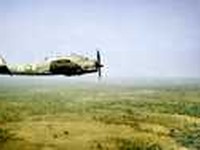
Beaufighter A19-17

A19-36
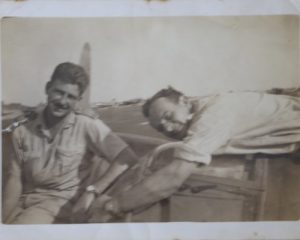
Harry and “Killer” lying across the engine cowl of a Beaufighter
Throughout the period between February 1943 to November 1943, Harry served under officers, Sqn Ldr Gordon Savage, Sqn Ldr Gordon, Sqn Ldr C.F. Read DFC, and Wing Commander F.W.B. Mann DFC.
Harry’s original logbook records that he served with 31 Sqn between 20/02/43 – 18/03/43 and 20/05/43 – 02/01/44.
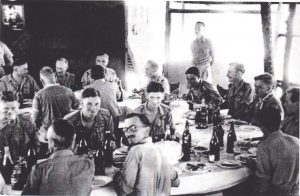

Debriefing with CO. W.Mann
On the 21st November 1943 Harry and Killer crashed when taking off for a strike. The aircraft involved was A19 – 82 and it appears from the logbook that this was the only flight undertaken by Harry and Killer in this particular aircraft.
Extract from logbook
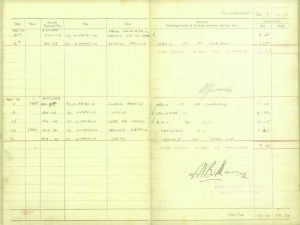
Crashed on takeoff
“Nov 21, A19 – 82, Pilot Sgt. Kilpatrick, Strike (crashed on take off)”
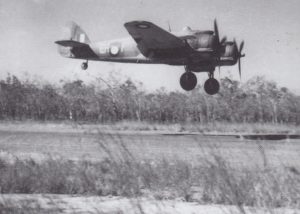
According to ADF Serials Numbers, A19 – 82 was converted to parts after the crash to service other aircraft.
Harry was again placed in hospital at 1 MRS between 21/11/43 and 24/11/43 as a result of the accident.
At the end of his service with 31 Squadron Harry had recorded 275.10 flying hours with the squadron made up of;
- 31 Operational sorties
- 131.45 operational hours flown
- 75.45 other hours flown
- Date of first sortie 25/2/43
- Date of last sortie 15/11/43
(Extract from logbook)

Flying Hours
Throughout his time with 31 Squadron at Coomalie Harry only ever flew with “Killer” (with the exception of 45 mins with F/Sgt Muggleton on a test flight on the 20th July 1943). Harry and “Killer” remained lifelong mates and attended many Anzac day services together until Harry passed away in 1971.
It is recorded in his logbook and service records that after leaving 31 Sqn, Harry went on to complete more than 8 additional postings and was attached to various Squadrons and locations in Australia and overseas.
Harry’s postings included;
- No.1 (E.D.) Training Group, Embarkation Depot, Ransford NSW. 2/1/44 – 30/1/44
- No. 2 AOS, Mt Gambier where Harry instructed in Navigation (predominantly in Anson aircraft and some Tiger Moths) 31/1/44 – 26/3/44, 17/4/44 – 7/5/45, 13/8/45 – 10/12/45 as well as acting as CO of the Wireless Telegraphy School and for a period station Signals Officer.
- Attached No 2. ED, 27/3/44 – 16/4/44.
- General Reconnaissance School (GRS) Bairnsdale, 7/5/45 – 13/8/45
- 93 Sqn. Navigator. Flying Australian built Beaufighters A8 – 47, 94, 102, 116, 133, 159, 260, 262, 270, 318, 324, 329, 318, as well as Ansons.
He was involved in ferry and test flights, royal mail and escort duties within the Asia Pacific area.
These included such places as Moratai and Labuan and then associated duties with the Occupation Force in Japan 10/12/45 – 15/5/46. This later period included some time in US Army L5 aircraft.
- 36 Sqn. Beaufighter A8-316, predominately C47 aircraft. Navigator duty. Areas of operation included Townsville, Lae, Rabual, Port Moresby, Katherine, Darwin, Moratai, Samar, Clark Field to Okinawa and areas within Japan.
Extract from logbook:
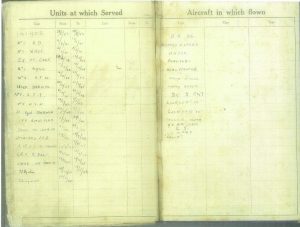
Postings & Attachments
Whilst serving at 2 AOS in Mt Gambier Harry (dad) first met my mother Margaret (known as Betty) a WAF, who was serving as a telephonist in the Signals section. For a time Harry was Station Signals Officer and therefore mum’s boss.
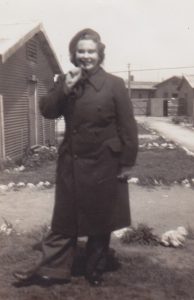
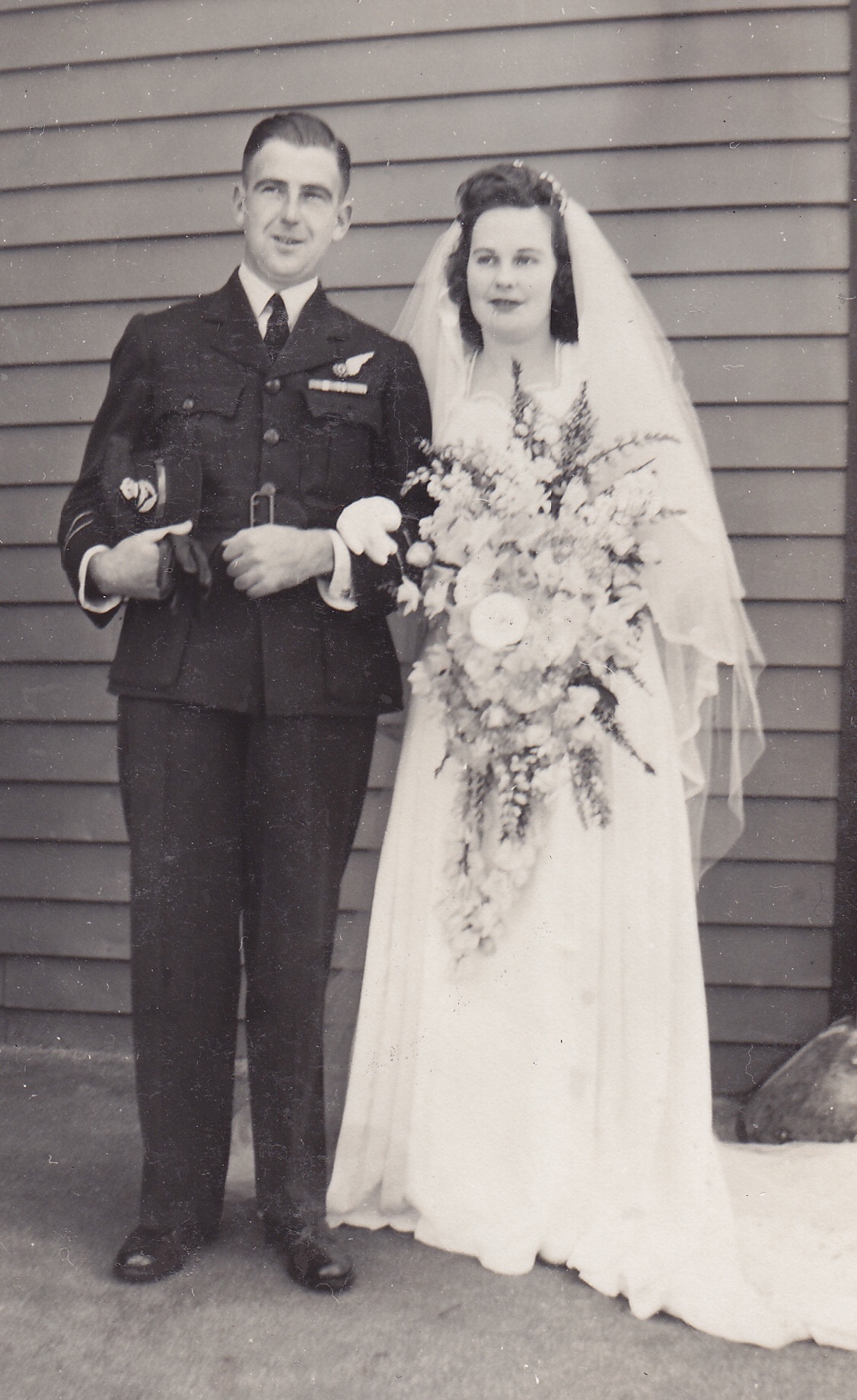 Harry and Margaret married in 1946 prior to his discharge from the RAAF.
Harry and Margaret married in 1946 prior to his discharge from the RAAF.
Footnote;
I would like to acknowledge the assistance of Ian Madden (son of Jack Madden also of 31 Sqn) and Richard Luxton (current owner of Coomalie farm on which WW2 Coomalie Airfield exists) for providing access to the airfield and a wealth of knowledge about the operations of 31 Sqn in WW2.
